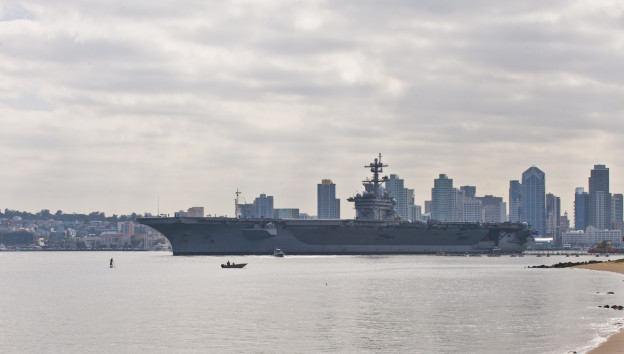
The dirty word spreading across the U.S. Navy and the larger defense establishment this year is “sequestration.” It was never supposed to happen, yet today it is the law of the land. Worse still, there appears to be no interest in Congress to repeal this legislation. That’s significant, since the longer this process goes on, the greater will be the cumulative damage on the long-term health and readiness of the U.S. Navy, as well as all of America’s military.
Sequestration was born out of the Budget Control Act of 2011, which stipulated that more than $900 billion in defense cuts over 10 years would begin automatically in 2013 unless Congress passed a long-term deficit reduction plan. This provision was considered so draconian that all agreed at the time that it would never be implemented. Think again.
Sequestration is here, and its impact is being felt all across the fleet every day by the imposition of thousands of cuts in hundreds of Navy commands — from the “grounding” of the Blue Angels to the postponement of hospital ship deployments to Latin America. Still, it’s not generating “big news” like that which would happen if a multibillion-dollar program like the Joint Strike Fighter or Ford-class aircraft carrier were suddenly canceled.
Instead, sequestration’s impact is covert, almost sinister, since the law mandates every program and every part of the Navy’s budget must incur the same percentage reduction. This provision leaves service leaders with no flexibility in how to prioritize cuts or shield more important efforts from the budget knife. No wonder Navy Secretary Ray Mabus has called this process “mindless.”
Fewer warships will be upgraded or overhauled; aircraft maintenance will be scaled back; routine base and facility upkeep will be postponed; personnel furloughs will likely continue into coming years. All of these issues will affect regional businesses and local jobs.
A 2012 study found that the Department of Defense spent about $20.6 billion a year in San Diego County alone, accounting for more than 311,000 jobs and generating more than $32 billion in local revenue — more than double what the region derives from tourism. As sequestration takes hold, this local economic lifeblood will undoubtedly plummet.
Keep in mind that these cuts are taking place at a time when the operational demand for Navy and Marine forces by regional commanders is on the upswing. The deployment lengths for aircraft carriers, amphibious ships and ballistic missile-equipped surface ships are all exceeding the Navy’s six-month deployment standard. Carrier Strike Groups and Amphibious Ready Groups will deploy for seven- to eight-month deployments in 2013, while BMD destroyers could deploy for nine-month tours of duty. This may well be the new normal for Navy ship deployments.
Navy leaders are attempting to identify about $10 billion in cuts from the 2013 budget — funding for which arrived six months after the start of the government’s fiscal year last October. That means this budget slashing must be done in a dramatically compressed time frame before the fiscal year expires on Sept. 30, creating yet more upheaval in Navy planning. These cuts will ax about $4 billion from the sea service’s operations and maintenance budget and $6 billion from ship and aircraft procurement accounts.
Navy officials maintain the service is prioritizing funding and commitment to ensure there is sufficient naval presence in the Asia-Pacific and the Persian Gulf. The strategic rebalancing to Asia continues to receive the highest priority, and the near-term emphasis is on those ships and aircraft units scheduled to deploy later this year and then those units earmarked for deployment in 2014. But sequestration is beginning to bite — and bite hard — on naval deployments worldwide and other vital needs.
Some 2013 cutbacks in operations and procurement include:
• Canceling one ship deployment to the Pacific, two deployments to Europe and almost all deployments to U.S. Southern Command in the Gulf of Mexico and South Atlantic.
• Significantly reducing the amount of time nondeployed ships get underway in home waters.
• Deferring depot maintenance on 84 aircraft and 184 engines.
• Two-thirds of the fleet will be downgraded as not mission capable and will not be certified to conduct major combat operations.
• Defer about $1 billion in facilities upgrades and sustainment ashore (which will take five years to recover).
• Cutting procurement of E-2D Hawkeye, F-35C Lightning, P-8A Poseidon and MQ-8 manned and unmanned aircraft.
• Pushing out shipbuilding schedules and “costs to complete” some ships that will have to be reconciled in future budgets.
Deft budgetary maneuvers, including using funds provided in previous budget years but not yet obligated, enabled Navy officials to deflect much of sequestration’s impact this year. But in 2014, if sequestration is not rescinded, the situation becomes more dire — and fast. The Navy cut for 2014 will be $10 billion to $14 billion below this year’s total. Programs will be reduced if not eliminated, uniformed and civilian personnel will be furloughed, and contractors will be out of jobs.
Navy officials warn this will entail wholesale reductions in naval operations, maintenance and procurement. The service will have less flexibility to reflect costs. The net result will be a Navy less ready to protect the maritime commons.
Welcome to the messy — and dangerous — world of sequestration.




